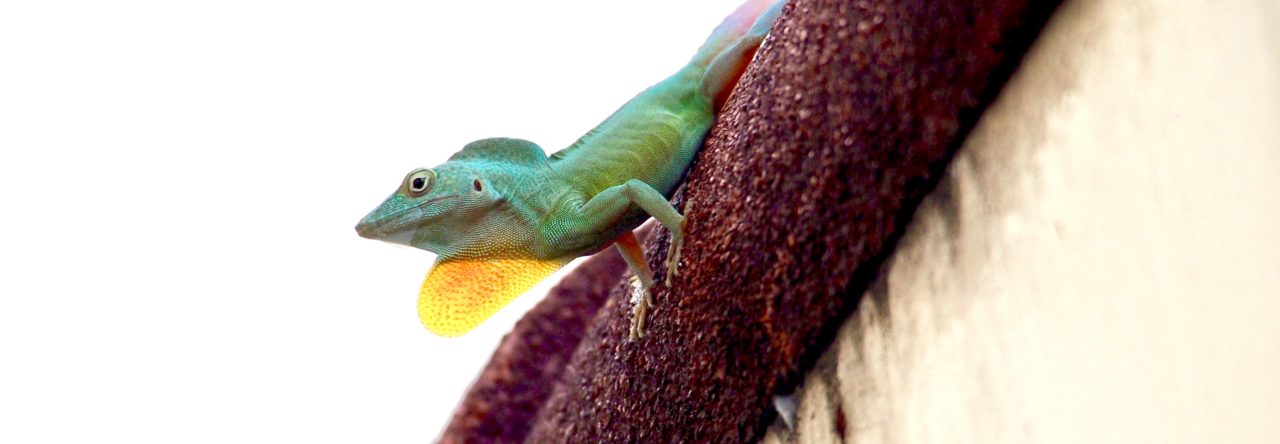
Anolis sagrei on the beautiful island of Bimini
I just got back from a 10 day research trip to Bimini in the western Bahamas along with Harvard post-doc, Graham Reynolds, Harvard graduate student, Pavitra Muralidhar, and UMass Boston undergraduate, Jason Fredette. We went with the simple goals of kicking off a research project in the Losos lab on Anolis sagrei and to observe as many other herps as we could.
We spent the majority of our time on South Bimini. We sampled from the well-maintained Nature Trail, where we found all four anole species (Anolis sagrei, Anolis smaragdinus, Anolis angusticeps, and Anolis distichus) and a Bimini boa among diverse habitat types, including blackland coppice and open Coccothrinax shrub. We also spent a couple of nights searching in some mangrove forest near the airport, which yielded only A. sagrei and A. angusticeps and in low abundance at that. The “Fountain of Youth” ended up being a gold mine for Sphaerodactylus nigropunctatus as well as boas — we caught 3 here.

Male Anolis sagrei

Anolis smaragdinus

Anolis angusticeps
We also did a fair amount of exploring. Our hosts for our house rental wanted to make sure we had a great time in Bimini and so they insisted on boating us out to a couple of the nearby islands for some snorkeling. They even provided us with the best full face snorkel mask I’ve ever laid my eyes on. We picked up a boat for the ride at the Intrepid Powerboats website. Of course, we saw this as the perfect opportunity to catch a few lizards. Our first destination was Gun Cay, a small island a few miles to the south of Bimini. Pavitra and Jason entertained our hosts by collecting shells and feeding stingrays. Meanwhile, despite our hosts’ curiosity that we wanted to go wander in the brush, Graham and I nabbed 10 adult male A. sagrei in less than an hour. We also saw several Ameiva auberi, Anolis smaragdinus, and some sort of very large rodent (does anyone know about Hutia reintroductions in the Bahamas?).
The following day, our hosts insisted we come with them to a small island 20+ miles to the north of Bimini (Great Isaac Cay) where they promised us dolphins and hammerhead sharks. On the way to the island we saw several dolphins, tons of flying fish, sea turtles, and several large nurse sharks. As we approached the island, I saw the mature Casuarina forest and yelled down to Graham from the crow’s nest tower, “I want to go explore there!” Our hosts got us as close as they could to the rocky shore (dangerously close it seemed, the hull almost hit the rocky karst island) and all four of us hopped onto the island. The island had an abandoned lighthouse and buildings from the 1800’s that we explored. We were shocked to not find a single anole on Isaac Island, although we did find Sphaerodactylus nigropunctatus and Ameiva auberi.

The isolated Great Isaac Cay with ruins from the late 1800’s.
The trip was a huge success. In total, we came across all but five of the reptiles of Bimini. Surprisingly, we were unable to find any Bahamian racers (Alsophis vudii) other than roadkills, though most of our field time was at night. Unsurprisingly, we did not find either of the blind snakes or the dwarf boa, the latter of which tends to be more common in the rainy season. As expected, A. sagrei was the most abundant anole on Bimini. We came across A. angusticeps and A. smaragdinus with equal frequency and actually encountered only a few A. distichus. We did most of our searching at night, so this may be a reflection on different sleeping behaviors rather than abundance.
In summary, we were able to observe:
- 140+ Anolis sagrei males and females
- 9 Sphaerodactylus nigropunctatus (black-dotted dwarf gecko)
- 1 Sphaerodactylus argus (ocellated dwarf gecko)
- Dozens of Leiocephalus carinatus (curly-tail lizard)
- 5 Chilabothrus strigilatus fosteri (Bimini boa)
- a handful of Anolis distichus, Anolis smaragdinus, Anolis angusticeps
We also saw a number of other herps that we were not able to catch or didn’t need data from:
- Ameiva auberi (Bimini ameiva)
- Eleutherodactylus planirostris (greenhouse frog)
- Osteopilus septentrionalis (Cuban tree frog)
- Hemidactylus mabouia (invasive house gecko)
This slideshow requires JavaScript.






















